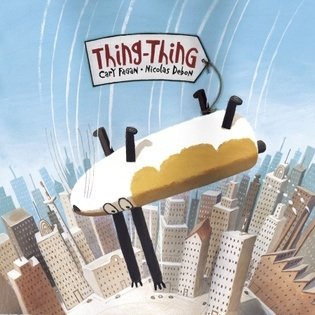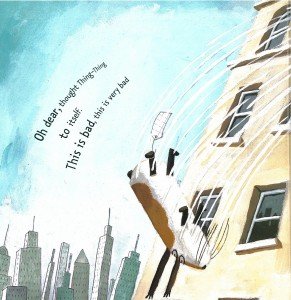The thing about Thing-Thing is that hesitation is not always the best policy, which contradicts everything I said in my previous blog about mindless accumulation. I first identified Thing-Thing as a jewel worthy of plucking about a year ago. The title, in particular, appealed to me, as did the art, but for some reason, I hesitated. Thing-Thing was a one of one in the bookstore, and it stayed that way for six months, until the day it disappeared from the shelf. The day, of course, when I finally realized it was time to bring Thing-Thing home. Presumably, the book had been sent back to the publisher, but maybe someone less diffident than me had picked it up. I hope so. Books that are returned to the publisher eventually get sent back on giant lots with other ‘remainder’ stock, only this time, the sad history of their early rejection is slashed across their bottoms with a big black marker. I was able to retrieve the book from the publisher before it suffered a completely undeserved fate. Thing-Thing is now my Thing-Thing, and it is most assuredly one of my favourite things.
It begins with a spoiled brat named Archibald Crimp (Dickens would approve) throwing a hissy fit, declaring that he is ‘not getting out of this bed‘ (Naomi Campbell would approve) until his parents bring him a present better than all the electronic games, racing cars, and robots littering the floor of the hotel room in the BIG CITY, where the family is staying for the little snot’s birthday. The exasperated, but pathologically indulgent parents oblige, and the father heads over to the nearest toy store. There, on a top shelf, he finds Thing-Thing, who was ‘not quite a bunny rabbit, but not quite a dog either, nor a bear, or cat for that matter.’ Dad brings the toy home and Little Lord Archibald promptly throws it out the window. End of story? No. Thing-Thing’s slow descent to the pavement is where the story actually begins.
At first, Thing-Thing is worried. He had hoped to be given to someone who would ‘love it, and talk to it, and make it tea parties, and dress it up, and hang onto it when sad or lonely, and get it sticky with jam, and take it to bed.’ (Funny, that’s exactly what I’m looking for!) However, though it appears that this is not Thing-Thing’s destiny, rather than succumb to his plight he quickly bypasses the first four stages of grief, heading straight into the fifth: pants-wetting, I mean, acceptance.
Thing-Thing makes a number of observations as he falls: that a robin’s nest resting on a window ledge several floors below contained the loveliest blue eggs he had ever seen, that it’s a nice day (in spite of everything), and that a spider spinning a web under a gargoyle, who warns Thing-Thing to Look Out For The Ground, clearly did not have a full grasp of his predicament. As anyone who has ever fallen out of a building can attest, sometimes you are ‘ears-up, and sometimes you are ‘ears-down,’ and as Thing-Thing explains to the spider, ‘I can’t really look out for the ground. It is more like the ground should look out for me.’ A fine piece of philosophy, I’d say.
Thing-Thing’s eventual landing is a soft one, in the arms of a crying baby in a stroller. Archibald the Unready makes an appearance and tries to lay claim to the toy, but is quickly hauled off by his parents. Apparently, they’ve had an ephiphany following the appearance, and subsequent disappearance of Thing-Thing. This is true of everyone in the book, even those who only see Thing-Thing for a moment as he glides by their windows. The perspective, both visual and observational, flips between the people in the hotel rooms and Thing-Thing, in various positions, spiraling down through the air. While the design of the book is very dynamic, as is the story, the author allows just enough time to get to know a few creatures, human and otherwise, and to cheer for the fate of a thing that is not quite a dog, nor a bear, but a kind of mirror, reflecting an entire world in in just a few seconds.
Thing-Thing was written by Cary Fagan, an award-winning Toronto author who, I now know, is capable of quite wonderful…uh…things. He has found a perfect partner in Nicolas Debon, who I first became aware of in 1999, when he published a beautifully illustrated picture book, A Brave Soldier, about a Canadian soldier in WWI. It’s part of my collection, but I admit that at first I didn’t recognize Debon’s illustration style in Thing-Thing. A Brave Soldier is very atmospheric, very blue, both in tone and colour. Appropriately so, the art of Thing-Thing draws from a far more exuberant and bright palette. The acrylic paintings are full of humour, and the characterizations are absolutely charming, especially Thing-Thing, who couldn’t be more loveable, whatever he is, bear, cat, or my guess, antelope.
My only suggestion is that the publisher missed an opportunity by not simultaneously offering a Thing-Thing stuffed toy. I may not have many spaces left on my bookshelves, but along with the book, I would have found a nice, cozy spot for Thing-Thing, the toy. Unlike young Mr Crimp, I know a keeper when I see it. Next time, though…no hesitation.
Thing-Thing, written by Cary Fagan and illustrated by Nicolas Debon, published by Tundra Books, 2008. ISBN: 978-0887768392
A Brave Solder by Nicolas Debon, published by Groundwood Books, 1999



